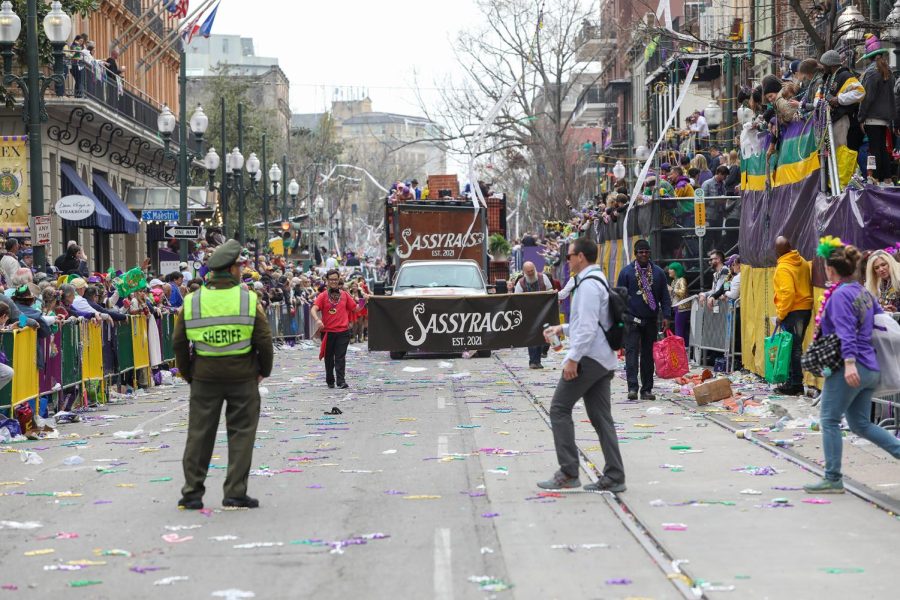Krewes react to shortened Mardi Gras routes
The SassyRacs Krewe rolls during the Tucks parade on Feb. 26 as a police officer guards the street. Parades like Tucks will have to decrease the length of their routes due to a lack of police presence.
December 9, 2022
As the Crescent City prepares for its biggest celebration after the holidays, Carnival krewes and businesses are having to brace themselves for the effects of parade routes shortening for the second year in a row.
Short staffing in the New Orleans Police Department, which came about due to the COVID-19 pandemic, has led to the changes in the route. Parade goers and float riders alike are figuring out how to keep the fun going throughout the season regardless.
Mayor LaToya Cantrell’s Mardi Gras committee announced in October that parade routes would be curtailed in 2023 as they had been in 2022, citing a lack of manpower to line the routes.
Uptown parades will begin on Napoleon Avenue and Prytania Street rather than Napoleon Street and Tchoupitoulas Street, a nine-block cut that effectively bypasses Magazine Street. This has caused krewes to adapt and plan accordingly, and has urged businesses along Magazine Street to plan for a loss.
The Krewe of Tucks’ parade route cut has frustrated Lloyd Frischhertz, captain and founder of the group. Krewe of Tucks has been parading since 1969, when it started out as a group of Loyola students.
“We absolutely want those six blocks back,” Frischhertz said. “There’s no reason to cut ours short.”
Frischhertz added that, while he recognizes the police force’s current staffing constraint, the route Tucks takes does not require as much police surveillance as the lengthier routes do.
“That is a family area,” Frischhertz said. “The parade starts at noon, no one is drinking, no one is drunk, and the crowd is never out of control.”
Captain of the Krewe of Freret and Loyola alumnus Bobby Hjortsberg seconded Frischhertz. He said that while the route shortening is understandable and that the number one priority is for everyone to be safe, it’s difficult to not feel discouraged.
“It’s disappointing because you put so much time, money, effort, and everything into producing the parade, so you want to be out there as long as possible,” Hjortsberg said.
The Krewe of Freret has been rolling since 2011, when it was established by seven Loyola graduates who wanted to “preserve the Mardi Gras tradition, unify enthusiastic young professionals, support local industry, and infuse vigor into Carnival while revitalizing the Freret corridor,” their website said.
Hjortberg argued that there might be some areas that are going to be overpopulated due to shorter routes, closer to Napoleon and St. Charles avenues but that he’s confident it won’t have a big effect on safety.
“There’s no one in the world better at dealing with crowds than New Orleans,” Hjortsberg said. “We’ve got that down to a science, if nothing else.”
Mass communication professor and next year’s Krewe of Freret King Ty Lawson said that the shortening of the route didn’t bother him much last year, but said that was due to “post-Covid excitement” to have Mardi Gras rolling again. He said he doesn’t think it will be a problem next year either.
“If this year was any indication, I think it will be fine,” Lawson said. “Mardi Gras is organized chaos that we absolutely love.”
Lawson said that he assumes the parade routes will stay shortened until the NOPD shortage is addressed, but that won’t stop krewes from celebrating.
“Mardi Gras is the greatest free show on earth for a reason,” Lawson said. “No one is going to let anything ‘rain on our parades.’”










G G • Dec 9, 2022 at 12:27 pm
Shortage of police is not due to Covid 19! It is all over the news…